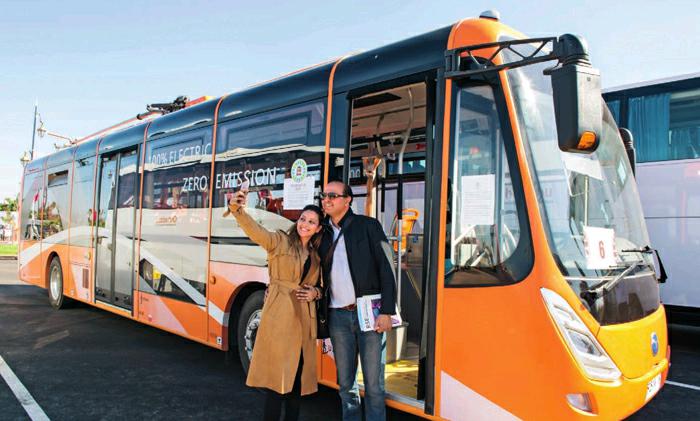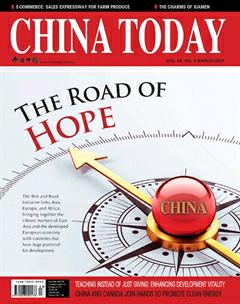Belt & Road Initiative to Galvanize Green Cooperation
By+staff+reporter+LIU+YI
IN the global age of freely circulating information and capital, environmental protection is the most pressing issue for every country on earth. The whole world is facing the huge challenge posed by climate change, decreasing biodiversity, and environmental pollution. People everywhere have realized that the only way forward is to confront the challenges side by side.
The Chinese government has long valued the environment. As early as 1983, with the Second National Environmental Protection Conference, environmental protection was confirmed as a basic state policy. As we move further into the 21st century, additional laws and policies have been drafted to support environmental protection, in addition to more widespread public education. The 18th National Congress of the CPC, held in 2012, lifted the concept of building an ecological civilization to the level of national strategy and made it a guiding principle for national governance.
So when the Belt and Road Initiative was first proposed in late 2013, a strong environmental element was included in the planning. In November 2015, the theme of the annual meeting of the China Council for International Cooperation on Environment and Development was “Green Belt and Road Initiative.”
The China Council, chaired by Vice Premier Zhang Gaoli, is a high-level consultancy that facilitates exchanges between Chinese leadership and international environmental policymakers. Its choice of theme directly reflects the focus of the Chinese government. The 2016 meeting had the theme: “Ecological Civilization: China and the World.”
The Acting Director of the Asia Pacific Office of the UN Environment, Dr. Isabella Louis, attended the China Council meeting last December. “China established the China Council 25 years ago to learn from the experience of other countries,” said Dr. Louis, who has worked in sustainable development and natural resource management since the 1980s. “Now China has developed its own expertise in this field, and is now able to provide assistance to other countries.”
During her most recent trip to China, Dr. Louis joined the MOU signing ceremony between UN Environment and Chinese Ministry of Environmental Protection (MEP) agreeing to cooperate in making the Belt and Road Initiative greener. This is the first MOU Chinese government has signed regarding the environmental issue of the Belt and Road Initiative.
Complex Environmental Situation in Asia-Pacific
According to the UN Environment, the Asia-Pacific region covers the largest area geographically and has the biggest population. The region encompasses 41 countries. Bounded in the west by Iran and Afghanistan, it extends its reach south to include Australia and New Zealand, Mongolia in the north, and Japan and Pacific island nations in the east.
The geographical area designated by the UN Environments Asia-Pacific region overlaps with key regions involved in Chinas Belt and Road Initiative, prompting the Chinese government to sign the MOU with the UN Environment in the hope of receiving professional consultancy and policy suggestions.
The Asia-Pacific Region is facing huge challenges in terms of environment and ecology. According to The Regional Assessment for Asia and the Pacific of the Sixth Global Environment Outlook (GEO-6), the flagship report of the UN Environment, published in June 2016, 41 percent of the worlds natural disasters over the last 20 years occurred in the Asia Pacific region, affecting as many as 4.5 billion people and resulting in economic losses of US $1.1 trillion.
This is due in part to the regions rapid economic growth. An increase in the middle-income population gave rise to rapid urbanization, with around 120,000 people moving from rural to urban areas every day: more than half the worlds megacities are in Asia Pacific. Industrialization, urbanization, and lifestyle changes are all placing mounting pressure on natural resources and ecosystems.
The current situation in Asia-Pacific becomes clear if we examine priority issues highlighted for each region by the UN Environment. Environmental problems actually reflect the different development stages of each region (see Figure 1).
Looking at countries on an individual basis, however, an even more complex situation becomes apparent. In Asia Pacific there are advanced countries like Singapore and Japan which have long-established policies and legal frameworks to deal with environmental issues. There are some less developed countries and small island nations that need substantial external support; and there are some “advanced developing countries” (as Dr. Louis calls them) such as China and India which, due to rapid development and ballooning populations, are hampered by severe environmental problems, but which also have ample capital and the determination to address the issue.
“This is a very diverse region, which is undergoing dynamic change,” said Dr. Louis. “To tackle the current problems demands long-term joint efforts.”
Green Investment Promoted by the Belt and Road Initiative
The MOU signed between UN Environment and the MEP aims to build a platform of information sharing and green finance to facilitate the sustainable development of the Belt and Road Initiative. Through close cooperation, the platform will focus on and assess the different development stages, environmental situations, and the influence of various infrastructure projects along the Belt and Road routes.
Dr. Louis explained that environmental cooperation within the region currently relies on two models. The first involves inter-governmental organizations such as ASEAN. Southeast Asian countries cooperate through ASEAN on issues like energy and water resources. The UN Environment Asia Pacific Office also cooperates with ASEANs environmental department to pilot initiatives like promoting energy-efficient light bulbs. The second model involves using the private sector, which is more market-oriented.
The “Green Belt and Road” is expected to add a new dimension to the fabric of regional environmental governance with a combination of investment and green finance.
“Infrastructure projects that destroy the environment during construction and have no adequate measures in place to rectify the damage should not be eligible for loans.” Dr. Louis believes that green finance and credit will encourage companies to take on more social responsibilities towards the environment.
In fact, the Chinese government is already aggressively promoting green finance. At the beginning of 2016, at the behest of the Chinese G20 presidency, the G20 established the Green Finance Study Group(GFSG). At the conclusion of the Hangzhou Summit in September 2016, the G20 Leaders Communiqué fully endorsed the comprehensive report drafted by GFSG, and explicitly expressed its support in increasing green investment and financing and facilitating transnational green bond investment.
Green finance is expected to give businesses more of an incentive. “If a company is revealed to be failing to meet environmental standards, people wont buy its stocks, which will compel it to raise the bar,” said Dr. Louis. As a result, those companies that care about the environment and observe environmental laws will bet-ter their reputation and gain capital, creating a positive cycle in the market.
Multiple Measures to Facilitate Exchange
Though the main body in building the green Belt and Road comprises the various businesses involved, the Chinese government has also taken multi-aspect action on national, regional, and international levels to help companies better comply with the laws and regulations of the countries they invest in, thereby avoiding environmental risk.
September 2016 saw the official launch of the Belt and Road Ecological and Environmental Protection Data Platform. Using big data and satellite remote sensing technology, the website has scoped out the ecological and environmental conditions of China and the countries along the Belt and Road. It also provides information about the environmental policies, regulations, standards, technology, and industrial development in different countries. The data provided on the website will be an important tool for companies looking to invest and operate overseas.
One of the websites earliest achievements is the “Belt and Road Ecological and Environment Blue Paper” published at the end of 2016. It analyzes environmental management policies, water and atmospheric environment, solid wastes and soil pollution, nuclear pollution, and international cooperation on the environment of various countries. The Blue Paper assesses 26 countries, including Russia, Kazakhstan, Mongolia, India, Cambodia, Malaysia, and Turkey.
“Every country has a different situation,” said Dr. Louis. She added that some countries are making efforts to build an environmental legal system, while some have already established a system but need stronger law enforcement. Some countries have a rampant illegal trade in wild animals and some island nations need to address their continued survival crisis as the oceanic ecology deteriorates.
“When Chinese companies invest overseas they should meet local standards,” said Dr. Louis, “but they also need to demonstrate higher environmental standards, for example, by training local employees and communities, because the standards in some countries are comparatively much lower.”
For the Chinese government, existing bilateral and multiple cooperation mechanisms are also used to improve environmental cooperation. In the second half of 2016, the Chinese government held a series of environmental forums: the Ecological and Environmental Cooperation Conference of the Eurasian Economic Forum in Xian, Shaanxi Province; the China-Arab States Forum on Environmental Protection in Yinchuan, Ningxia Hui Autonomous Region; and the China-ASEAN Environmental Cooperation Forum in Nanning, Guangxi Zhuang Autonomous Region. An environmentallyfriendly urban development partnership was officially established between China and ASEAN countries in September 2016.
The Ministry of Environmental Protection also established the Belt and Road Environmental Technology Exchange and Transfer Center in Shenzhen City, Guangdong Province, in April 2016. This was a key action promoting cooperation in technology used to com- bat atmospheric pollution and improve the treatment of wastewater and solid wastes.
Today Chinas influence is strong in the Asia-Pacific region and beyond. Chinas ratifying of the Paris Agreement last September was a catalyst for the success of the Climate Change Conference in Marrakech, Morocco, last November.
Regarding the Belt and Road Initiative which involves so many countries, each with their own unique situations, Dr. Louis pointed out that “China and other countries need in-depth dialogues to identify their different needs and to meet them with our experience and expertise.”
“I think the story will gradually play out over the next few years,” she said, with confidence in a green Belt and Road. “The journey has just started.”
- CHINA TODAY的其它文章
- Sci-Tech
- The Road of Hope
- Pakistan Showcases Achievements in Belt and Road Cooperation
- Enhancing Connectivity in East Africa: The Addis Ababa-Djibouti Railway
- Building Lifelines in Tajikistan–Tebian Electric Apparatus Stock Co.
- Chinese Projects Bring New Opportunities to Aktogay in Kazakhstan

